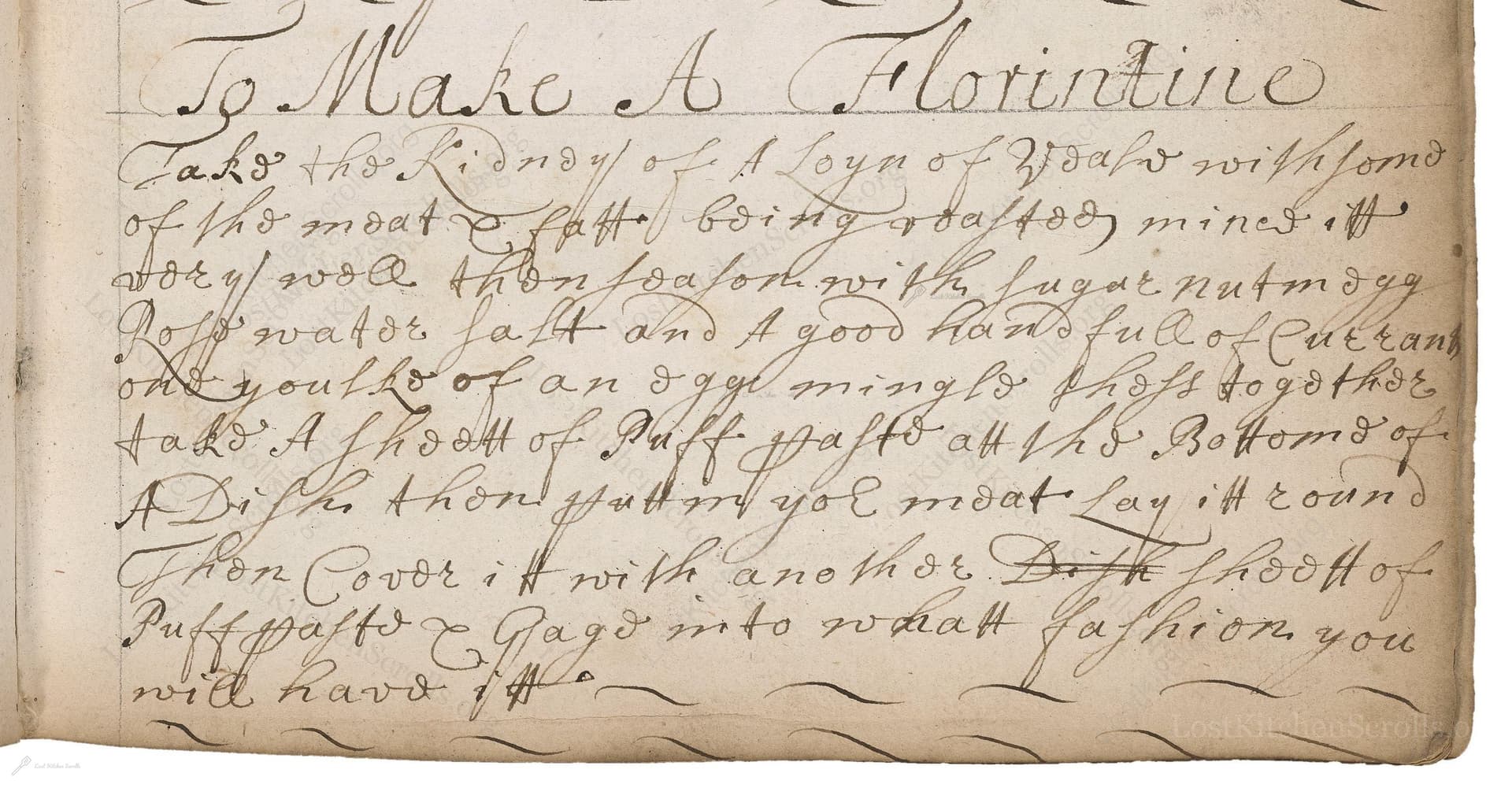To Make A Florintine
From the treasured pages of Cookbook of Ann Smith, Reading
Written by Ann Smith

To Make A Florintine
"Take the Kidny of A Loyn of Veale with some of the meat & fatt, Being roasted, minc'd it very well, Then toss with, sugar nutmegg Rosewater Sallt And a good Handsfull of Currants mingld those togdthor. Take A Shoott of Puff pasto & Lay it att the Bottome of A Dishe Then put in you meat Lay it round Then Cover it with another thick Shoott of Puff pasto & Gagd into whatt fashion you will Have ittt."
Note on the Original Text
The recipe is written in a conversational, run-on style typical of English manuscript cookery of the late 1600s. Spelling is unstandardized ('Kidny', 'pasto', 'gagd'), and punctuation is fluid. Ingredients and method are interwoven, assuming the cook’s familiarity with standard procedures, such as making puff pastry or roasting meat, which are not spelled out in detail. The instruction to 'gagd into whatt fashion you will Have ittt' is a playful nudge for creative pastry shapes—a freedom often encouraged in period recipes.

Title
Cookbook of Ann Smith, Reading (1698)
You can also click the book image above to peruse the original tome
Writer
Ann Smith
Era
1698
Publisher
Unknown
Background
Step into the sumptuous kitchens of 17th-century England with Ann Smith’s culinary treasury, where traditional recipes and time-honored techniques invite you to savor the flavors of history. Each page promises a feast of inspiration and a glimpse into the artful dining of a bygone era.
Kindly made available by
Folger Shakespeare Library
This recipe comes from a late 17th-century English manuscript, the collection of Ann Smith, dated 1698. Recipes like this Florintine (or Florentine) pie reveal the era’s penchant for combining sweet and savory flavors, enriched with costly ingredients like veal, sugar, and imported spices and dried fruit. Ingredients such as rosewater and currants were hallmarks of upper-class cookery, reflecting global trade in the Stuart period. At the time, puff pastry was a technical tour-de-force, and a pie like this, elegantly shaped, would be a showpiece at a fashionable table.

Cooks in 1698 would roast the meat using a hearth or spit and chop it finely by hand with heavy knives or a wooden chopping bowl and curved chopper. Puff pastry would be made from scratch using butter and flour and rolled with a wooden rolling pin. The pie was assembled in a deep ceramic or metal dish and baked in a wood-fired oven, with coals above and below to ensure crisp pastry. Vent patterns were often cut with blunt knives or special pie jiggers to create decorative shapes.
Prep Time
30 mins
Cook Time
35 mins
Servings
6
We've done our best to adapt this historical recipe for modern kitchens, but some details may still need refinement. We warmly welcome feedback from fellow cooks and culinary historians — your insights support the entire community!
Ingredients
- 9 oz veal kidney, roasted
- 9 oz veal loin meat (with some fat), roasted
- 2 tbsp (scant 1 oz) caster sugar
- 1/2 tsp grated nutmeg
- 1 tsp rosewater
- Pinch of sea salt
- 1 3/4 oz dried currants
- 9 oz puff pastry (store-bought or homemade)
Instructions
- Start by roasting the kidney and some meat (with fat) from a pork loin until golden and cooked through.
- Once cooled, finely mince about 9 oz of kidney and 9 oz of roasted veal loin with some of the fat.
- In a bowl, combine the minced meat with 2 tablespoons (scant 1 oz) caster sugar, 1/2 teaspoon grated nutmeg, 1 teaspoon rosewater, a generous pinch of salt, and about 1 3/4 oz of currants.
- Mix thoroughly so the currants and seasonings are well distributed.
- Roll out 9 oz of ready-made or homemade puff pastry to about 1/4 inch thick and line the bottom of a baking dish with half.
- Spread the meat mixture evenly on top, smoothing it out.
- Cover with a second layer of puff pastry, sealing the edges.
- Cut decorative vents or patterns in the top.
- Bake in a preheated oven at 375°F for about 30-35 minutes, or until the pastry is puffed and golden.
- Let rest a few minutes before slicing.
Estimated Calories
390 per serving
Cooking Estimates
Preparing this recipe will take about 30 minutes, including roasting and mixing the filling, and 35 minutes for baking. Each slice is estimated to have about 390 calories, and the whole pie makes 6 servings.
As noted above, we have made our best effort to translate and adapt this historical recipe for modern kitchens, taking into account ingredients nowadays, cooking techniques, measurements, and so on. However, historical recipes often contain assumptions that require interpretation.
We'd love for anyone to help improve these adaptations. Community contributions are highly welcome. If you have suggestions, corrections, or cooking tips based on your experience with this recipe, please share them below.
Join the Discussion
Rate This Recipe

Den Bockfisch In Einer Fleisch Suppen Zu Kochen
This recipe hails from a German manuscript cookbook compiled in 1696, a time whe...

Die Grieß Nudlen Zumachen
This recipe comes from a rather mysterious manuscript cookbook, penned anonymous...

Ein Boudain
This recipe comes from an anonymous German-language manuscript cookbook from 169...

Ein Gesaltzen Citroni
This recipe, dating from 1696, comes from an extensive anonymous German cookbook...
Browse our complete collection of time-honored recipes



